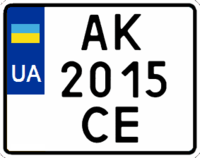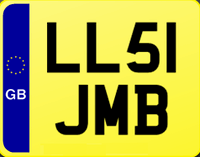Vehicle registration plates of Europe
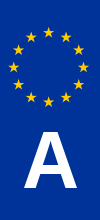
(A denotes Austria).
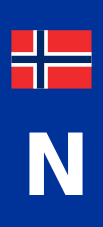

A European vehicle registration plate is a vehicle registration plate, a metal or plastic plate or plates attached to a motor vehicle or trailer for official identification purposes. The registration identifier is a numeric or alphanumeric code that uniquely identifies the vehicle within the issuing authority's database. In Europe most countries have adopted a common format for number plates, such as the common EU format issued in EU member states. This format satisfies the requirements in the Vienna Convention on Road Traffic, which states that cross-border vehicles must display a distinguishing code for the country of registration on the rear of the vehicle. This sign may be an oval sticker placed separately from the registration plate, or may be incorporated into the vehicle registration plate. When the distinguishing sign is incorporated into the registration plate, it must also appear on the front registration plate of the vehicle, and may be supplemented with the flag or emblem of the national state, or the emblem of the regional economic integration organisation to which the country belongs.[1]
Format
The bulk of European countries issue license plates that are 520 by 110 mm (20.5 by 4.3 inches) or 520 by 120 mm (20.5 by 4.7 inches). This is one of the basic standard sizes worldwide: the others are:
- 305 by 152 mm (12.0 by 6.0 inches)
- 305 by 160 mm (12.0 by 6.3 inches)
- 372 by 135 mm (14.6 by 5.3 inches)
Some European countries use license plates in other formats:
- 330 by 140 mm (13.0 by 5.5 inches) in Andorra.
- 440 by 120 mm (17.3 by 4.7 inches) in Finland.
- 260 by 110 mm (10.2 by 4.3 inches) in Monaco.
- 390 by 120 mm (15.4 by 4.7 inches) in San Marino.
- 300 by 80 mm (11.8 by 3.1 inches) in Switzerland and Liechtenstein (only front plates).
European Union
The common EU format of having a blue section on the extreme left with EU circle of stars and the country code was introduced by Council Regulation (EC) No 2411/98 of 3 November 1998[2] and entered into force on the 11 November 1998. It was based on a model registration plate which three member states had already introduced: Ireland (1991),[3] Portugal (1992) [4] and Germany (1994).[5] Luxembourg plates had displayed the EU flag on the left since 1988. Vehicles with EU number plates do not need to display the white oval international vehicle registration code while within the European Economic Area (EEA), or in countries signatory to the Vienna Convention on Road Traffic.[6]
- The common design consists of a blue strip on the left side of the plate. This blue strip has the EU flag symbol (twelve yellow stars), along with the country code of the member state in which the vehicle is registered. Danish plates have a small holographic strip to the right of the blue EU strip.
- EU format plates are either white or yellow, on a plate wider than it is tall. Yellow registration plates are used both front and rear in Luxembourg and the Netherlands. In Gibraltar, the United Kingdom and Cyprus, yellow plates are used at the rear and white at the front. The UK uses flat plastic plates (embossed metal plates are an option in the UK), as opposed to metal plates in most other European countries. A mixture of plastic and metal plates is permitted in France and Ireland. Plastic plates have earlier also been used in Sweden and Norway.
- Denmark and Hungary use yellow plates for vehicles registered as commercial vehicles. In Greece, Latvia, Lithuania and Sweden yellow plates are used for taxi vehicles. Belgium uses red characters and is the only country not to use the standard black-on-white or black-on-yellow combination; with the introduction of European-style plates in November 2010, a slightly darker shade of red was chosen (RAL 3003) to improve legibility. In Norway, cars with front seats only (used for carrying goods) have green plates with black characters.
- The use of the EU flag on registration plates is optional for member states, but they must accept it as a valid distinguishing sign of a foreign vehicle's country of origin.
- Within the United Kingdom, motorists with vehicles registered in Great Britain may use number plates featuring the national flag of England, Scotland or Wales, or alternatively the Union Flag, together with the code name "ENG" for England, "SCO" for Scotland, "Wales" or "CYM" for Wales, "GB" for Great Britain or "UK" for United Kingdom respectively.
Other countries
Several non-EU European states have implemented formats similar to the EU format, replacing the circle of stars with their own symbols. Vehicles with such number plates do not need to display the white oval international vehicle registration code while within countries signatory to the Vienna Convention on Road Traffic.[6]
- Norway is an example of such a state, issuing europlates with the Norwegian flag replacing the circle of stars. Iceland issues plates with the Icelandic flag above the country code on the left side, but without the blue strip. Of those states that joined in the 2004 enlargement of the European Union Malta already used europlates, while Latvia, Poland and Lithuania had used EU number plates displaying the national flag before their accession, as did Bulgaria and Romania before their accession in 2007.
- Turkey is not a member of the EU, but it uses the blue European strip on the left of the plate as a member of European Customs Union (the only member of the union without EU membership), with the country code (TR), but without the 12-EU stars sign.
Common letter and digit systems between countries
Several countries have made efforts to avoid duplicating registration numbers used by other countries. Nevertheless, this is not completely successful and there are occasional difficulties for example in connection with parking fines and automatic speed cameras.
- Belgium (until 2010), Cyprus, Finland, Georgia (until 2014), Hungary, Lithuania, Malta, Sweden (since 1974), and Moldova (since 2014) each use combinations of first three letters and then three digits.
- Bulgaria uses plate numbers in the form A[A]-0000-A[A], i.e. one or two letters representing the region, then four digits, then one or two more letters. All letters used are intersection of Latin and Cyrillic alphabet, i.e. A, B, C, E, H, K, M, O, P, T, X and Y.
- Greece uses a combination of three letters (which are chosen from the 14 character shapes which appear in both the Latin and the Greek alphabet (but not necessarily with the same sound values), i.e. A, B, E, Z, H, I, K, M, N, O, P, T, Y, X in Greek alphabetic order) and four numbers, in the form of AAA-0000, while Spain uses a four number-three letter combination, in the form of 0000 BBB (vowels and some maybe confusing consonants, like Ñ and Q, are not used)
- Denmark and Norway use two letters and five digits, while trailers use two letters and four digits. The plates look very similar, but Denmark has a red border around the plate. Use of the country code on the plate may mitigate this problem (Norway began using the system on 1 November 2006). Denmark has begun running out of combinations in this style and has now introduced combinations previously reserved for the Faroe Islands for EU style number plates (which will use different letters from non-EU style plates).
- The Netherlands (until recently) and Portugal both use three groups of two characters (letters or numbers) in several sequences: AB-12-CD, 12-34-AB, 12-AB-34, AB-12-34, etc. However, Portuguese plates have a white background, while those of Netherlands (after 1 January 1978) have a yellow one, though both countries also use white letters on blue plates for classic cars. Furthermore, newer plates on Dutch vehicles only contain consonants, to avoid coincidental abbreviations or words. Also some sensitive letter combinations, such as SS or SD, are not used. The combination 'AA' is reserved for cars of the royal family. Dutch company registered bus, truck and/or minivan plates always start with a B or a V. Dutch taxis use blue registration plates. The number of new combinations ran out in 2008. New registered cars in the Netherlands now use the format of two digits-three letters-one digit (12-ABC-3).
- Belgium used the sequence ABC-123 between 1973 and 2008. When these combinations ran out in 2008, the inverse sequence 123-ABC was adopted, with the first plate in the new series issued on June 25, 2008. With the introduction of the European format on November 15, 2010, a seven-character combination 1-ABC-234 is used and the previous 123-ABC was discontinued. However, the six-character plates will remain valid, and no date is set for their expiration. Since Belgian plates are linked to an owner rather than to a vehicle, these older plates are likely to remain in use for a considerable time. As a way to phase out the six-character plates, future vehicle subscriptions will only be possible on the seven-character plates.
- Luxembourg plates use two letters and four digits AB 1234. An older series with only three digits (AB 123) is no longer issued but is still in use.
- Current registrations allocated in Romania and the United Kingdom (where the registration contains two digits) are both of the form AB12 CDE. The Romanian rear plates are white whereas UK ones are yellow. There is also a difference in the spacing and the font. In 2015, Bucharest, the capital of Romania, adopted the form B 123 AAA, three digits and three letters, because the number of cars had risen. In the United Kingdom, B123 AAA was issued to cars registered from August 1984 to August 1985.
- Sweden. Until 1973/74 the Swedish pattern was one letter representing the län (county) where the car was first registered, followed by four or five digits. However, in the more populated län, a second letter was introduced over time. For exmample, vehicles from southernmost county got the letter M + five digits, later also MA + five digits, MB + five digits etc. A problem was that the two northernmost counties had already been given two letters, the letter prefixes AC and BD, as the number of usable letters exceeded the number of counties. The ABC 123 system was introduced gradually from July 1973 until June 1974.
- Slovakia uses AB 123CD and Serbia and Croatia uses AB 123-CD (in both cases also other patterns are possible). All three countries use a coat of arms after first two letters, and the fonts and colors also look very similar. The plates can be easily distinguished by country code on the blue strip on left.Croatia and Serbia uses Č,Š,Ž for some municipality codes while in Slovakia C,S,Z are used instead.
There are also many municipality codes that are same in all three countries.
- Montenegro and Serbia, currently not members of the EU, used the following: MM 12-34, MM 123-45 or MM 123-456 (MM being two letter abbreviation of municipality), and having state flag (of former Yugoslavia, later Serbia and Montenegro) between municipality and numbers. Montenegro left that system in 2007, and introduced new format: MM AB 123, with Montenegrin coat of arms in circular shape between municipality and letter sequence. Blue strip with MNE country code is placed in the left side, with vacant place for EU stars, in case of joining the Union. Serbia also uses new system since 2011. with blue strip country code SRB: MM 123-AB and MM 1234-AB, with Serbian coat of arms between municipality and number sequence. The first two letters on the Serbian plates represent the municipality code, written in Latin letters, and repeated in Cyrillic characters with small letters under the coat of arms. The following system is used for taxi vehicles: BG 123 TX or BG 1234 TX and recently even BG 12345 TX, where a TX combination is reserved for this purpose only (another taxi vehicles have private vehicle plates). Since 2017, Serbia stopped issuing plates with last two letters containing W, Q, Y, X (except TX), Č, Ć, Š, Ž, and Đ, however Serbian Latin letters with diacritics are still used to mark the municipality code, like ČA for Čačak or ŠA for Šabac.
- Poland and the United Kingdom have both used AAA 123A. In Poland these were issued from 1976-2000, in the UK, they were issued from 1963-1983, with those issued prior to 1973 being the same colour as their Polish counterparts (white on black). These plates are still valid in both countries.
Differing numbering systems
Individual European countries use differing numbering schemes and text fonts:
- Most countries, including Austria, Bulgaria, Croatia, the Czech Republic, Germany, Greece, Ireland, Macedonia, Montenegro, Norway, Poland, Romania, Serbia, Slovakia, Slovenia and Switzerland (formerly also Sweden until 1974, Italy until 1994, Bosnia and Herzegovina until 1998, Lithuania and Spain until 2000, Estonia until 2004 and Albania until 2011, also former countries East Germany until 1990, Soviet Union until 1991, Czechoslovakia until 1993, Yugoslavia until 1998 and Serbia and Montenegro until 2011, have systems in which there is a direct link between a letter or letters appearing on the plate and the town or district where the plate was issued (e.g. "B" and "M" in Germany for Berlin and Munich, "TN" and "ZV" in Slovakia for Trenčín and Zvolen, "BG" and "KG" in Serbia for Belgrade and Kragujevac and "AX" and "KY" in Greece for Achaea and Corfu). Some countries, including Austria, Germany, Slovenia, and Switzerland, even include a regional or municipal coat of arms on the plate, but Croatia, Montenegro, Serbia and Slovakia include a national coat of arms. In Ireland, all plates have the name of the county of registration in Irish in smaller letters on the top.
- France (until 2009), and Turkey and Russia (since October 2013) use a system with an indirect number relation to the car's place of registration.
- The UK uses a system based on the region where the car was first registered and the date of registration, for example CA52 GJK, where the "C" stands for Wales (the name of that country in Welsh being Cymru), the "A" stands for Cardiff (the letters A-O assigned to the city), and the "52" means that the car was registered in the period September 2002 to February 2003.
- Belgium, Bosnia and Herzegovina, Denmark, Iceland, Estonia (after 2004), Finland, Hungary, Latvia, Lithuania (after 2000), Luxembourg, the Netherlands, Portugal and Sweden (after 1974) use plates that do not denote the location where the car is registered. Since 2000 Spain no longer uses province codes on plates but codes like 'B' for Barcelona or 'M' for Madrid can still be seen, for cars registered before that date. Italy, also, did not use the province codes on plates between 1994 and 1999.
- Italy, since 1999, has added a blue strip on either side. On the right one are the two digits of the year when the plate was issued (e.g. "99", "05", "08") and below that there may be an optional two-letter code for the province, such as "MO" for the Province of Modena. Albania and France have adopted similar formats.
- Irish license plates also contain the year in which the vehicle was registered. A car registered in 2008 would have the format 08-XX-XXXX. In 2013, this was updated to specify which half of the year the registration occurred. So from January to June, the license plate would show (for 2018) 181-XX-XXXX, whereas from July to December, the plate instead shows 182-XX-XXXX.
- Turkish license plates consist of letters and digits in combinations of 99 AB 999, 99 A 9999, 99 ABC 99, 99 AB 9999 or 99 A 99999 where the first two digits show which province the vehicle is registered from. First two digits numbers go from 01 to 81 (as there are 81 provinces in Turkey) and each one is assigned to a province with alphabetical order e.g. 01 is the code of the province Adana or 34 is the code of the province Istanbul. All 81 provinces uses "01 AB 123" style plates initially until all combinations ran out, then the province starts to use 01 A 1234 then 01 ABC 12 etc. As a result, three largest provinces i.e. Istanbul, Ankara and İzmir are currently issuing 99 AB 9999 style plates since they used all combinations of previous series but the province Sivas for example, still issues 99 AB 999 plates as having a modest population and number of vehicles. 99 A 99999 series are not regular since they are only used in provinces where commercial vehicles are abundant e.g. Bursa to distinguish these vehicles there from passenger cars. Letters "I" and "O" are only used in the middle 01 ABC 12 series e.g. 34 YOC 34 or 06 TIL 56 to avoid confusion with numerals "1" and "0" respectively. Also some letters combinations like "PKK" are not issued due to their referring to political organizations or words likely to cause offence.
Cross-border traffic
According to the Vienna Convention on Road Traffic, vehicles in cross-border traffic are obliged to display a distinguishing sign of the country of registration on the rear of the vehicle. This sign may either be placed separately from the registration plate or may be incorporated into the vehicle registration plate. One of the main benefits of the convention for motorists is the obligation on signatory countries to recognize the legality of vehicles from other signatory countries. The following requirements must be met when driving outside the country of registration:
- The physical requirements for the separate sign are defined in Annex 3 of the Vienna Convention on Road Traffic, which states that the letters shall be in black on a white background having the shape of an ellipse with the major axis horizontal. The distinguishing sign should not be affixed in such a way that it could be confused with the registration number or impair its legibility.
- When the distinguishing sign is incorporated into the registration plate, it must also appear on the front registration plate of the vehicle, and may be supplemented with the flag or emblem of the national state, or the emblem of the regional economic integration organization to which the country belongs. The distinguishing sign should be displayed on the far left or far right on the registration plate. When a symbol/flag/emblem is also displayed, the distinguishing sign shall obligatory be placed on the far left on the plate. The distinguishing sign shall be positioned so to be easy identifiable and so that it cannot be confused with the registration number or impair its legibility. The distinguishing sign shall therefore be at least a different color from the registration number, or have a different background color to that reserved for the registration number, or be clearly separated from the registration number, preferably with a line.[1]
Countries
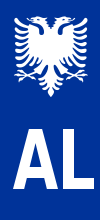


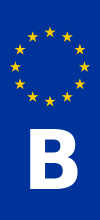

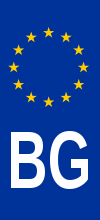
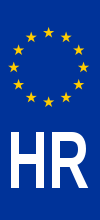

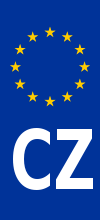
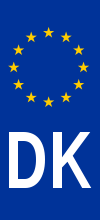
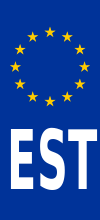
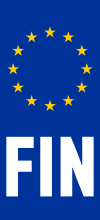

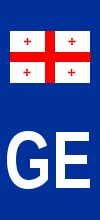

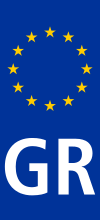
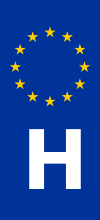


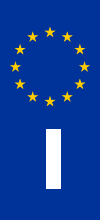
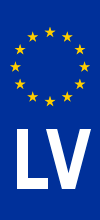
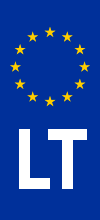
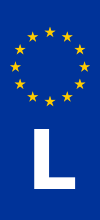
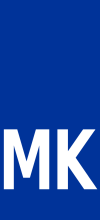
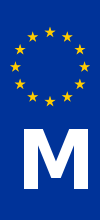
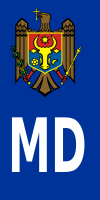

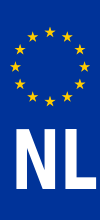

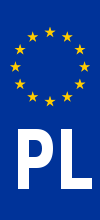
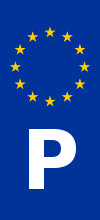


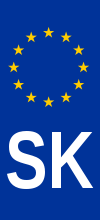

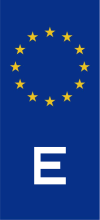
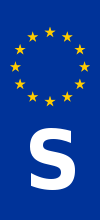


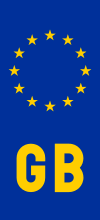
Dependencies and disputed territories
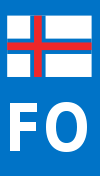
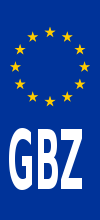
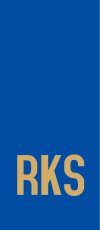
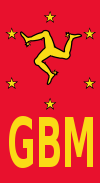
List
Vehicle registration plates of each country are described in the following table:
Countries [7]
Dependencies and disputed territories
| Territory | Code | Example |
|---|---|---|
| AX |  | |
| FO | ||
| GBZ |  | |
| GBG | ||
| GBM | ||
| GBJ | ||
| RKS | ||
| CY | ||
Motorcycle plates
These are used for motorcycles and vehicles where mounting space is an issue, such as taxis which display their licence plate beside the registration plate, and vehicles imported from countries where the mounting space was not originally designed to take European-sized plates (e.g. USA).
Countries
Dependencies and disputed territories
| Territory | Code | Example |
|---|---|---|
| RKS | ||
See also
References
- 1 2 http://www.international-driving-permit.com/Convention-on-Road-Traffic/8-November-1968/EN/Annexex/Annex-3-Distinguishing-Sign-of-Motor-Vehicles-and-Trailers-to-International-Traffic.aspx
- ↑ "EUR-Lex - 31998R2411 - EN - EUR-Lex". Retrieved 26 May 2016.
- ↑ "S.I. No. 287/1990 - Road Vehicles (Registration and Licensing) (Amendment) Regulations, 1990". Retrieved 26 May 2016.
- ↑ "License Plates of". Retrieved 26 May 2016.
- ↑ "License Plates of Germany". Archived from the original on 13 February 2007. Retrieved 26 May 2016.
- 1 2 "Convention on Road Traffic, of 8 November 1968 (2006 consolidated version), Annex 3" (PDF). 3 September 1993.
When the distinguishing sign is incorporated into the registration plate(s), the following conditions shall apply: [...] When, in addition to the distinguishing sign, a non-numerical symbol and/or a flag and/or a regional or local emblem is displayed on the registration plate, the distinguishing sign of the State of registration shall obligatorily be placed on the far left of the plate
- ↑ http://matriculasdelmundo.com/europeas.php European license plates
External links








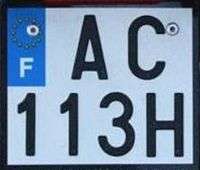


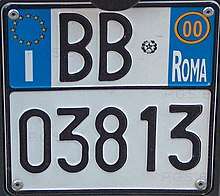


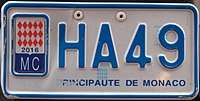

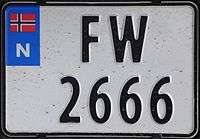
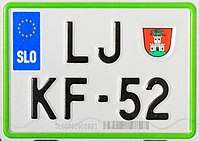
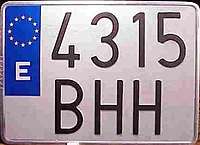
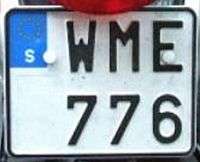
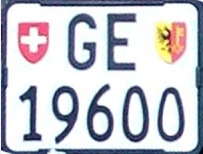
.jpg)
